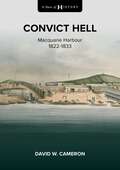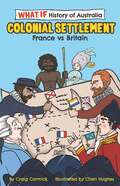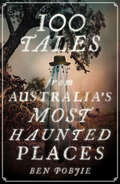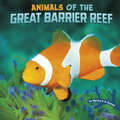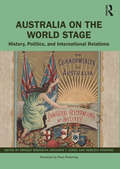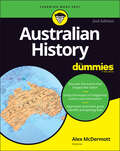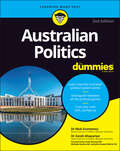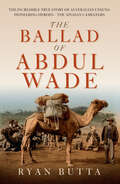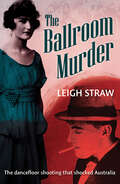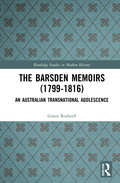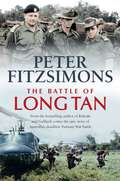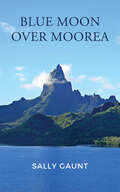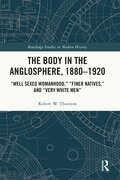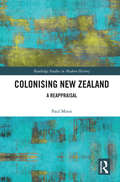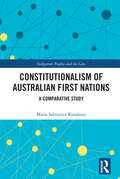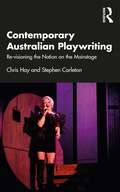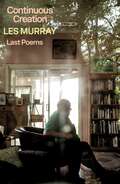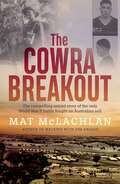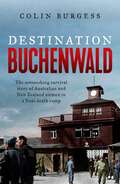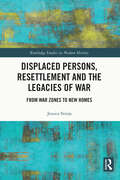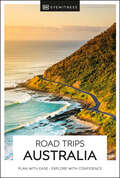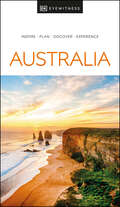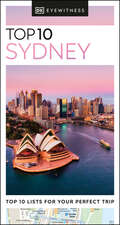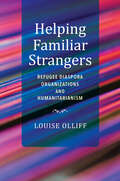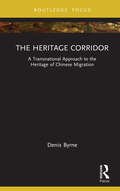- Table View
- List View
A Shot of History: Macquarie Harbour 1822-1833 (A Shot of History #1)
by David W. CameronThe year 2022 marks the 200th anniversary of the establishment of the penal settlement at Macquarie Harbour. This convict penal settlement located on the isolated primeval rugged west coast of Van Diemen&’s Land (Tasmania) quickly gained a reputation as an &‘Earthy Hell&’. Colonial historian John West succinctly recorded in 1852: &‘The name Macquarie Harbour is associated exclusively with remembrance of inexpressible depravity, degradation, and woe. Sacred to the genius of torture, Nature concurred with the objects of its separation from the rest of the world, to exhibit some notion of a perfect misery. There, man lost the aspect and the heart of man …. This region is lashed with tempests: the sky is cloudy, and the rain falls more frequently than elsewhere. In its chill and humid climate, animal life is preserved with difficulty; half the goats died in one season, and sheep perished; vegetation, except in its coarsest and most massive forms is situated and precarious …. The passage to this dreary dwelling place was tedious and often dangerous. The prisoners, confined in a narrow space, were tossed for weeks on an agitated sea. As they approached, they beheld a narrow opening chocked with a bar of sand and crossed with peril. This they called Hell&’s Gate – not less appropriate to the place than to the character and torment of the inhabitants: beyond they saw impenetrable forests, skirted with an impervious thicket; and beyond still enormous mountains covered with snow, which rose to the clouds like walls of adamant: every object wore the air of rigour, ferocity, and sadness&’. This was just the beginning for those sentenced to Macquarie Harbour the barbaric treatment from officials and fellow convicts alike, resulted in Macquarie Harbour representing a true convict hell hole, not only resulting in murder, but in cannibalism by several men in their attempts to escape.
The What If Histories of Australia: Colonial Settlement: France vs Britain
by Craig CormickAn amusing look at the alternative paths that Australian history might have taken.The What If histories of Australia imagines a very different history of Australia, where the unexpected happens in unexpected ways. Starting by defining the real histories, the book then looks at possible paths of different settlements that history could have taken. What if Captain Cook&’s ship sank when it hit the Great Barrier Reef in 1770? And what if the French settled Australia first? And what if King Louis 16th and Napoleon both ended up here, fighting over who was the rightful ruler in exile? And then the British arrived… A very different and amusing history of Australia, where the unexpected happens in unexpected ways.
100 Tales from Australia's Most Haunted Places
by Ben PobjieFrom the ghostly black horse of Sutton Forest to the butcher of Adelaide Street, a haunted Brisbane lift to the chilling experiments carried out by Doctor Blood of the North Kapunda Hotel, Australia abounds in spooky stories that are all unnervingly based in fact and tied to real places you can visit or avoid. In 100 Tales from Australia's Most Haunted Places, comedy writer and general scaredy-cat Ben Pobjie communes with the spirit world to send a shiver down your spine. A book best read with the light left on.
Animals of the Great Barrier Reef (Wild Biomes)
by Martha E. RustadBiomes are home to unique animals and plants. Introduce beginning readers to the Great Barrier Reef! Readers will get an up-close look at the characteristics of the reef and how corals, fish, anemones, rays, birds, and other animals have adapted to life in and around this amazing biome.
Australia on the World Stage: History, Politics, and International Relations
by Bridget Brooklyn Benjamin T. Jones Rebecca StratingAustralia on the World Stage: History, Politics, and International Relations offers a fresh examination of Australia’s past and present. From the complex interactions of First Nations to modern international relations with significant partners and allies, it examines the forces that have influenced the place now called Australia both historically and today. It is a unique history told in two parts. The first half of the book examines the way Australia acted on the world stage both before and after British colonisation. It outlines the evolution of Australia’s relationship with the United Kingdom, first as colonies, then a dominion, and finally as an independent nation. It finishes with a First Nations perspective on foreign relations. The second half of the book provides a wide-ranging history of Australia’s dealings with major powers, the United States and China, as well as its relationships with New Zealand, Aotearoa, the Pacific Islands, Indonesia, Japan, Antarctica, and the United Nations. Written by leading and emerging researchers in their fields, this book encourages the reader to consider Australia’s performance on the world stage over the longue durée, well before the word ‘Australia’ was ever dreamt up. This interdisciplinary work challenges lazy stereotypes that see Australia's international history as fixed and uncontested. In revisiting Australia’s foreign relations, this work also asks the reader to consider its future directions.
Australian History For Dummies
by Alex McDermottExplore the land down under with your friends at Dummies Australia might be most famous for kangaroos, koalas, friendly people, and decidedly unfriendly critters (like the black widow spider, yikes!), but did you know that its government was dismissed by the British Crown in 1975? Or that human beings have lived on the continent for around 65,000 years? In Australian History For Dummies, you???ll discover all that ??? and more ??? as you discover the history of Indigenous Australians, colonial explorers, and the modern inhabitants of one of the most fascinating nations, islands, and continents in the world today!
Australian Politics For Dummies
by Nick Economou Zareh GhazarianUnderstand Aussie politics and make your vote count! Australian Politics For Dummies gives you a helping hand as you get to grips with the good, the bad and the ugly of Australian politics. Seasoned political punters and voting novices alike will find fascinating facts and top thrills in in this essential guide. Master the ins and outs of elections, parties and policies. In no time, you'll be discussing and debating the biggest issues with ease. Down under, we all have to vote. It's one of the many beautiful things about this land of ours, and this book will help you learn why (and how) to cast that ballot. This updated edition gives you everything you need to cast your vote with confidence. You'll identify what makes the Australian political system tick, distinguish between the different political parties and understand the influence of the media in Australian politics. Decipher political terminology, make sense of the houses of parliament and understand why we have minor parties Learn how Australia's political system evolved and grasp today's voting systems Make sense of coalition politics and figure out the differences between the Labor and Liberal parties Find out why Australia's system of government is described as 'Washminster,' and discover the Whips and the Usher of the Black Rod You want to know more about Australian politics, but, if we're being realistic, it's very complicated. Australian Politics For Dummies clears it all up.
The Ballad of Abdul Wade: The Incredible True Story of Australia's unsung Pioneering Heroes - The Afghan Camelleers
by Ryan ButtaWhen Afghan entrepreneur Abdul Wade first brought his camel trains to the outback, he was hailed as a hero. Horses couldn't access many remote settlements, especially those stricken by flood or drought, and camel trains rode to the rescue time and time again.But with success came fierce opposition fuelled by prejudice. The camel was not even classed as an animal under Australian law, and, in a climate of colonial misinformation, hyperbole and fear, camel drivers like Wade were shown almost as little respect. Yet all the while, for those in need, the ships of the desert continued to appear on the outback horizon.After his interest was piqued by a nineteenth-century photo of a camel train in a country town, Ryan Butta found himself on the trail of Australia's earliest Afghan camel drivers. Separating the bulldust from the bush poetry, he reveals the breadth and depth of white Australian protectionism and prejudice. Told with flair and authority, this gritty alternative history defies the standard horse-powered folklore to reveal the untold debt this country owes to the humble dromedary, its drivers and those who brought them here.
The Ballroom Murder
by Leigh StrawIn August 1925, Audrey Jacob shot dead her former fiancé, Cyril Gidley, in full view of hundreds of guests at a charity ball in Perth's Government House. When she was arrested, she still held the gun in her hand. It was a open and shut case of wilful murder – that is until Jacob assigned prosecutor Arthur Haynes to her defence. His ability to play the press and the jury for sympathy would lead to a sensational result. Not only did Jacob escape the gallows, she was found not guilty of Gidley's murder. Straw, the author of a number of books about notable Australian female criminals, tells a story that is rich with first-hand newspaper accounts from the day.
The Barsden Memoirs: An Australian Transnational Adolescence (Routledge Studies in Modern History)
by Grant RodwellCovering the life of Josephus Henry Barsden from his birth in 1799 through his childhood to 16 years of age, the Barsden memoirs describe events from a Sussex smugglers’ inn, a convict ship to the colony of New South Wales, sealing and whaling expeditions to Van Diemen’s Land, and Barsden’s participation in a Tahitian civil war. The author assesses the value of memoirs, and of these memoirs in particular to students of history in respect to the transnational paradigm. He tests the historicity and veracity of their contents, and provides an engaging exegesis and graphical supplement of its contents. Of central importance is Barsden’s account of the Battle of Fe’i Pi, which was in many respects the Pacific’s equivalent to the contemporaneous Battle of Waterloo, such was its lasting impact on Pacific geopolitics. This was no ordinary childhood, and poses many questions about a transnational adolescent’s impact on major events. A fascinating read for scholars and students of Australian, Pacific, and British Colonial History, written with academic rigour but accessible to non-specialists.
The Battle of Long Tan
by Peter FitzSimonsFrom the bestselling author of Kokoda and Gallipoli comes the epic story of Australia's deadliest Vietnam War battle.4.31 pm: Enemy [on] left flank. Could be serious.5.01 pm: Enemy ... penetrating both flanks and to north and south.5.02: Running short of ammo. Require drop through trees.It was the afternoon of 18 August 1966, hot, humid with grey monsoonal skies. D Company, 6RAR were four kilometres east of their Nui Dat base, on patrol in a rubber plantation not far from the abandoned village of Long Tan. A day after their base had suffered a mortar strike, they were looking for Viet Cong soldiers. Then - just when they were least expecting - they found them. Under withering fire, some Diggers perished, some were grievously wounded, the rest fought on, as they remained under sustained attack.For hours these men fought for their lives against the enemy onslaught. The skies opened and the rain fell as ferocious mortar and automatic fire pinned them down. Snipers shot at close quarters from the trees that surrounded them. The Aussie, Kiwi and Yankee artillery batteries knew it was up to them but, outnumbered and running out of ammunition they fired, loaded, fired as Viet Cong and North Vietnamese Army forces just kept coming. And coming.Their only hope was if Armoured Personnel Carriers (APCs) could reach them before they were wiped out. The APCs did their best but low cloud and thunderstorms meant air support was stalled. A daring helicopter resupply mission was suggested but who would want to fly that? The odds against this small force were monumental...By far the deadliest battle for Australian forces in Vietnam, the Battle of Long Tan has a proud place in the annals of Australian military history - and every ANZAC who fought there could hold his head high.Peter FitzSimons, Australia's greatest storyteller, tells the real story of this classic battle. He reveals the horror, the bravery, the wins and the losses that faced our soldiers. He brings to life the personal stories of the men who fought, the events leading up to that memorable battle and the long war that followed, and the political decisions made in the halls of power that sealed their fates. The Battle of Long Tan is an engrossing and powerful history that shows the costs of war never end.
Blue Moon Over Moorea
by Sally GauntIn Blue Moon over Moorea, an anthology of poems by Australian lawyer and poet Sally Gaunt, the author mines some of her favourite themes to remarkable effect. Water in all its forms proves a constant inspiration, from ‘Swimming with Seahorses’ to the rapt, almost hallucinatory images of the title poem. Gaunt breathes new life into verse written for the reading community and brings a sharp eye and wry humour to the perennial subjects of love, sex and death. Many of the poems are boldly imaginative recreations of historical events, typically centred on the sea, while the cycle of feather poems that opens the book considers the concept of manhood versus mayhem in a social setting.
The Body in the Anglosphere, 1880–1920: "Well Sexed Womanhood," "Finer Natives," and "Very White Men" (Routledge Studies in Modern History)
by Robert W. ThurstonFocusing on the body in every chapter, this book examines the changing meanings and profound significance of the physical form among the Anglo-Saxons from 1880 to 1920. They formed an imaginary—but, in many ways, quite real—community that ruled much of the world. Among them, racism became more virulent. To probe the importance of the body, this book brings together for the first time the many areas in which the physical form was newly or more extensively featured, from photography through literature, frontier wars, violent sports, and the global circus. Sex, sexuality, concepts of gender including women’s possibilities in all areas of life, and the meanings of race and of civilization figured regularly in Anglo discussions. Black people challenged racism by presenting their own photos of respectable folk. As all this unfolded, Anglo men and women faced the problem of maintaining civilized control vs. the need to express uninhibited feeling. With these issues in mind, it is evident that the origins of today’s debates about race and gender lie in the late nineteenth century.
Colonising New Zealand: A Reappraisal (Routledge Studies in Modern History)
by Paul MoonColonising New Zealand offers a radically new vision of the basis and process of Britain’s colonisation of New Zealand. It commences by confronting the problems arising from subjective and ever-evolving moral judgements about colonisation and examines the possibility of understanding colonisation beyond the confines of any preoccupations with moral perspectives. It then investigates the motives behind Britain’s imperial expansion, both in a global context and specifically in relation to New Zealand. The nature and reasons for this expansion are deciphered using the model of an organic imperial ecosystem, which involves examining the first cause of all colonisation and which provides a means of understanding why the disparate parts of the colonial system functioned in the ways that they did. Britain’s imperial system did not bring itself into being, and so the notion of the Empire having emerged from a supra-system is assessed, which in turn leads to an exploration of the idea of equilibrium-achievement as the Prime Mover behind all colonisation—something that is borne out in New Zealand’s experience from the late eighteenth century. This work changes profoundly the way New Zealand’s colonisation is interpreted, and provides a framework for reassessing all forms of imperialism.
Constitutionalism of Australian First Nations: A Comparative Study (Indigenous Peoples and the Law)
by Maria Salvatrice RandazzoThe book considers Australian First Nations constitutionalism by drawing on the chthonic constitutional traditions of three distinct Australian First Nations legal orders: the Warlpiri, Yolngu, and Pintupi legal orders, in the endeavour of identifying, via a comparative analysis, a core of similarities to be drawn upon and articulate an emergent legal theory common to the three legal orders. The comparative analysis is undertaken at the most foundational levels of their legal traditions, via the prism of a legal paradigm elaborated with reference to an Australian Indigenous cosmological, ontological, and epistemological standpoint. The proposed legal theory comprises a broad overview, general concepts, normative principles, and general working principles. In so doing, the book expounds how Australian First Nations constitutionalism unfolds into holistic orders of spiritual, political, and legal authority that are explainable in terms of legal theory. At the most foundational level, such elaboration may help delineate normative and legal constitutional patterns throughout Indigenous Australia.
Contemporary Australian Playwriting: Re-visioning the Nation on the Mainstage
by Chris Hay Stephen CarletonContemporary Australian Playwriting provides a thorough and accessible overview of the diverse and exciting new directions that Australian Playwriting is taking in the twenty-first century. In 2007, the most produced playwright on the Australian mainstage was William Shakespeare. In 2019, the most produced playwright on the Australian mainstage was Nakkiah Lui, a Gamilaroi and Torres Strait Islander woman. This book explores what has happened both on stage and off to generate this remarkable change. As writers of colour, queer writers, and gender diverse writers are produced on the mainstage in larger numbers, they bring new critical directions to the twenty-first century Australian stage. At a politically turbulent time when national identity is fractured, this book examines the ways in which Australia’s leading playwrights have interrogated, problematised, and tried to make sense of the nation. Tracing contemporary trends, the book takes a thematic approach to the re-evaluation of the nation that is dramatized in key Australian plays. Each chapter is accompanied by a duologue between two of the playwrights whose work has been analysed, to provide a dual perspective of theory and practice.
Continuous Creation: Last Poems
by Les MurrayThe final collection of poems by the great Australian poet Les Murray, Continuous CreationWe bring nothing into this worldexcept our gradual abilityto create it, out of all that vanishesand all that will outlast us.In Continuous Creation, the final collection from Les Murray, the preeminent poet of modern Australia recalls moments from his youth and wryly observes the changing world, moving back and forth through time and history with characteristic curiosity and an ever-fresh commitment to capturing the rhythms of life in verse. This collection displays Murray’s miraculous ability to reinvent language in order to plant his and our reality on the page, whether he writes about the Australian landscape (“Kangaroo sleeping / ahead on the road turns out / to be twigs and leaves”) or unsold books sitting in department stores.Continuous Creation demonstrates, once more, that Murray was one of the great poets of the English language. As Joseph Brodsky said, he was, “quite simply, the one by whom the language lives.”
The Cowra Breakout
by Mat McLachlanThe riveting story of the missing piece of Australia's World War II history, told by bestselling historian Mat McLachlan (Walking with the Anzacs, Gallipoli: The Battlefield Guide).During World War II, in the town of Cowra in central New South Wales, Japanese prisoners of war were held in a POW camp. By August 1944, over a thousand were interned and on the icy night of August 5th they staged one of the largest prison breakouts in history, launching the only land battle of World War II to be fought on Australian soil. Five Australian soldiers and more than 230 Japanese POWs would die during what became known as The Cowra Breakout.This compelling and fascinating book, written by one of Australia's leading battlefield historians, vividly traces the full story of the Breakout. It is a tale of proud warriors and misfit Australian soldiers. Of negligence and complacency, and of authorities too slow to recognise danger before it occurred - and too quick to cover it up when it was too late. But mostly it is a story about raw human emotions, and the extremes that people will go to when they feel all hope is lost.
Destination Buchenwald: The astonishing survival story of Australian and New Zealand airmen in a Nazi death camp
by Colin BurgessThe harrowing story of the Allied airmen who experienced the true horrors of Nazism firsthand. It was the summer of 1944 as liberating Allied forces surged towards Paris following the D-Day landings. For a large group of downed airmen being held in that city&’s infamous Fresnes Prison, they were about to face evacuation into the blackest, bloody heart of Germany and experience the most acute evil of the war. Amid great secrecy, those 168 airmen – including several from Australia and New Zealand – were transported on a filthy, overcrowded nightmare train journey which ended at the notorious Buchenwald concentration camp, accompanied by orders for their execution. At Buchenwald they witnessed extreme depravity that would haunt them to the end of their days. Yet, on returning home, they were confronted by decades of denials from their own governments that they had ever been held in one of Hitler&’s most vile concentration camps. In conducting his original deep research for this book – now completely expanded and updated – Colin Burgess personally interviewed or corresponded with dozens of the surviving airmen from a number of nations, including their valorous leader, New Zealand Squadron Leader Phil Lamason. Destination Buchenwald tells a compelling story of extraordinary bravery, comradeship and endurance, when a group of otherwise ordinary servicemen were thrust into an unimaginable Nazi hell. 'This was the first book to provide an insight into our experiences as a group of captured allied airmen, betrayed to the Gestapo, tortured and deported to Buchenwald concentration camp. I consider it to be one of the best interpretations of the events as it reflects the voices of the survivors and their challenges to stay alive in such dehumanising circumstances.' Sqn Ldr Stanley Booker, RAF (Rtd.), MBE, Légion D'Honneur: Last surviving member of the Buchenwald airmen
Displaced Persons, Resettlement and the Legacies of War: From War Zones to New Homes (Routledge Studies in Modern History)
by Jessica StrojaThis book provides a case study on the ongoing impact of displacement and encampment of refugees who do not have access to resettlement support services, or are resettled in locations of low cultural and linguistic diversity. Following the journeys of displaced families and children who left Europe after the Second World War to seek resettlement in Queensland, Australia, this book brings together the rarely heard voices of these refugees from written archives, along with material from more than 50 oral history interviews. It thoroughly explores the impacts of displacement, encampment and eventually resettlement in locations without resettlement facilities or support networks. In so doing, the book brings to light important findings that can be used to help understand the experiences of those impacted by contemporary refugee crises, and can be considered when developing responses and assistance in locations where there is a lack of diversity or support for refugees. This book will be of interest to scholars and students studying and researching the history of migration, sociology of migration, psychological effects of migration and displacement, as well as demography. Practitioners and policy makers will also be able to draw from this book when considering the long-term impacts of responses to contemporary refugee crises.
DK Eyewitness Road Trips Australia (Travel Guide)
by DK EyewitnessWith its ever-changing landscapes, Australia is the perfect destination for a leisurely road trip. It's yours to explore with Road Trips Australia, our redesigned and newly updated guide containing 22 drives across the country, from the coastal roads of the southwest to the red-dirt tracks of the outback.Packed with insider tips and information, this easy-to-use guide reveals Australia at its best: spectacular sights, hidden gems and authentic local experiences. We've also worked hard to make sure our information is as up-to-date as possible following the COVID-19 outbreak. DK Eyewitness Road Trips Australia is your ticket to the trip of a lifetime. Inside DK Eyewitness Road Trips Australia you will find: - 22 easy-to-follow driving tours, each lasting one to seven days- A laminated pull-out road map of Australia helping you navigate with ease- Walks, delightful detours and activities to do along the way, plus you'll savor the best local -experiences with our pick of the most authentic places to stay, eat and shop- Practical tips: rules of the road, detailed directions and driving tips- Detailed maps and walks to help you navigate the country easily and confidently - Covers: Queensland, the Northern Territory, South Australia, Victoria, Tasmania and moreAbout DK Eyewitness: At DK Eyewitness, we believe in the power of discovery. We make it easy for you to explore your dream destinations. DK Eyewitness travel guides have been helping travelers to make the most of their breaks since 1993. Filled with expert advice, striking photography and detailed illustrations, our highly visual DK Eyewitness guides will get you closer to your next adventure. We publish guides to more than 200 destinations, from pocket-sized city guides to comprehensive country guides. Named Top Guidebook Series at the 2020 Wanderlust Reader Travel Awards, we know that wherever you go next, your DK Eyewitness travel guides are the perfect companion.
Eyewitness Australia (Travel Guide)
by DK EyewitnessWhether you want to enjoy a spectacular sunrise at Uluru-Kata Tjuta National Park, sip craft beer in one of Melbourne&’s many hidden bars or drive along the epic Great Ocean Road, your DK Eyewitness travel guide makes sure you experience all that Australia has to offer.Australia's scintillating cities are home to world-class galleries, burgeoning foodie scenes and a lively nightlife. Beyond the urban landscape lie some of the most diverse natural wonders on earth. From the sun, sand and surf of Australia&’s 10,000 beaches and tropical islands to the World Heritage-listed rainforests, underwater coral gardens and hauntingly beautiful arid interior – this epic landscape never fails to mesmerize and surprise.Our updated guide brings Australia to life, transporting you there like no other travel guide does with expert-led insights, trusted travel advice, detailed breakdowns of all the must-see sights, photographs on practically every page, and our hand-drawn illustrations which place you inside the country's iconic buildings and neighborhoods. We&’ve also worked hard to make sure our information is as up-to-date as possible following the COVID-19 outbreak. DK Eyewitness Australia is your ticket to the trip of a lifetime. Inside DK Eyewitness Australia you will find: - A fully-illustrated top experiences guide: our expert pick of Australia&’s must-sees and hidden gems- Accessible itineraries to make the most out of each and every day- Expert advice: honest recommendations for getting around safely, when to visit each sight, what to do before you visit, and how to save time and money- Color-coded chapters to every part of Australia, from Queensland to New South Wales, Tasmania to Victoria- Practical tips: the best places to eat, drink, shop and stay- Detailed maps and walks to help you navigate the country easily and confidently - Covers: Sydney, New South Wales, Canberra and Australian Capital, Territory, Victoria Tasmania, South Australia, Queensland, Northern Territory, Western AustraliaOnly visiting Sydney? Look out for DK Eyewitness Sydney or the pocket-sized Top 10 Sydney.About DK Eyewitness: At DK Eyewitness, we believe in the power of discovery. We make it easy for you to explore your dream destinations. DK Eyewitness travel guides have been helping travellers to make the most of their breaks since 1993. Filled with expert advice, striking photography and detailed illustrations, our highly visual DK Eyewitness guides will get you closer to your next adventure. We publish guides to more than 200 destinations, from pocket-sized city guides to comprehensive country guides. Named Top Guidebook Series at the 2020 Wanderlust Reader Travel Awards, we know that wherever you go next, your DK Eyewitness travel guides are the perfect companion.
Eyewitness Top 10 Sydney (Pocket Travel Guide)
by DK EyewitnessOverlooking one of the world&’s most spectacular harbours, Sydney is blessed with ocean beaches, lush tropical gardens, and a balmy climate that makes the great outdoors irresistible.Make the most of your trip to this dazzling city with DK Eyewitness Top 10. Planning is a breeze with our simple lists of ten, covering the very best that Sydney has to offer and ensuring that you don&’t miss a thing. Best of all, the pocket-friendly format is light and easily portable; the perfect companion while out and about. DK Eyewitness Top 10 Sydney is your ticket to the trip of a lifetime. Inside DK Eyewitness Top 10 Sydney you will find: - Top 10 lists of Sydney&’s must-sees, including Sydney Opera House, Art Gallery NSW, Darling Harbour and Bondi Beach- Sydney&’s' most interesting areas, with the best places for sightseeing, food and drink, and shopping- Themed lists, including the best beaches, museums, art galleries, parks and gardens and much more- Easy-to-follow itineraries, perfect for a day trip, a weekend, or a week- A laminated pull-out map of Sydney, plus eight full-color area mapsLooking for more on Australia&’s culture, history and attractions? Try our DK Eyewitness Australia.About DK Eyewitness: At DK Eyewitness, we believe in the power of discovery. We make it easy for you to explore your dream destinations. DK Eyewitness travel guides have been helping travellers to make the most of their breaks since 1993. DK Eyewitness travel guides have been helping travelers to make the most of their breaks since 1993. Filled with expert advice, striking photography and detailed illustrations, our highly visual DK Eyewitness guides will get you closer to your next adventure. We publish guides to more than 200 destinations, from pocket-sized city guides to comprehensive country guides. Named Top Guidebook Series at the 2020 Wanderlust Reader Travel Awards, we know that wherever you go next, your DK Eyewitness travel guides are the perfect companion.
Helping Familiar Strangers: Refugee Diaspora Organizations and Humanitarianism (Worlds in Crisis: Refugees, Asylum, and Forced Migration)
by Louise OlliffWho helps in situations of forced displacement? How and why do they get involved?In Helping Familiar Strangers, Louise Olliff focuses on one type of humanitarian group, refugee diaspora organizations (RDOs), to explore the complicated impulses, practices, and relationships between these activists and the "familiar strangers" they try to help. By documenting findings from ethnographic research and interviews with resettled and displaced persons, RDO representatives, and humanitarian professionals in Australia, Switzerland, Thailand, and Indonesia, Olliff reveals that former refugees are actively involved in helping people in situations of forced displacement and that individuals with lived experience of forced displacement have valuable knowledge, skills, and networks that can be drawn on in times of humanitarian crisis.We live in a world where humanitarians have varying motivations, capacities, and ways of helping those in need, and Helping Familiar Strangers confirms that RDOs and similar groups are an important part of the tapestry of care that people turn to when seeking protection far from home.
The Heritage Corridor: A Transnational Approach to the Heritage of Chinese Migration (Routledge Research on Museums and Heritage in Asia)
by Denis ByrneThe Heritage Corridor argues for a transnational approach to investigating and recording heritage places that emerge from histories of migration. Addressing the material legacy of migration, this book also relates it to issues of contemporary importance. Presenting an image of the built environment of migration as one shaped by the ongoing flows of people, ideas, objects and money that circulate through migration corridors, Byrne proposes that houses and other structures built by migrants in their home villages in China over the period 1840–1940 should be seen as crystallisations of the labour, aspirations and longings enacted and experienced by their builders while overseas. Demonstrating that the material world of the migrant is distributed across transnational space, the book calls for an approach to the heritage of migration that is similarly expansive. It proposes and illustrates new methods and strategies for heritage practice. The Heritage Corridor is a book for scholars and students in the fields of critical heritage studies, migration studies and Chinese diasporic mobilities. It is designed to be accessible to heritage practitioners, readers with an interest in the material worlds of migration, past and present, and to all those with an interest in the ‘archaeology’ of transnational migration.
